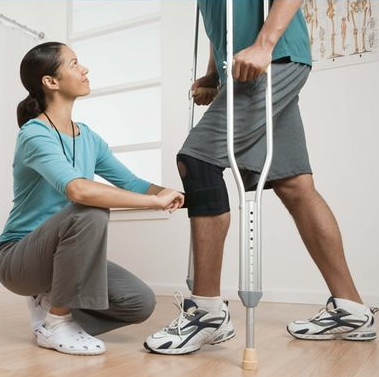Recovering After A Knee or Hip Replacement
Written by Stacy Benmore, Physiotherapist
So you have had your knee or hip replaced, everything went well and you are home from the hospital – now what?? A good place to start is physiotherapy, it helps to guide the recovery process, promote timely healing and facilitate safe return to physical activity. You may be asking: ‘But what does physiotherapy actually do after the joint replacement?’ ‘When do I start?’ ‘How long will I have to attend for?’ Here is some information to explain why it is so important to attend physiotherapy after your joint replacement.
1. To safely maximize the mobility in your new joint. After the surgery, the replaced joint needs to be moving – the leg and body will need the joint to move regularly to restore optimal function. Exercises need to be done daily to ensure normal expected ranges of motion in the knee/hip are achieved. It will not happen on its’ own. The movement you get out of the new joint is directly related to the work you put into it.
2. You will likely need to learn how to walk again! Patients have often been living with pain and difficulty moving for years before the hip or knee joint is replaced. In that time, the body will adapt its movement patterns to unload and get around the stiff arthritic joint – some muscles will become tighter or work harder, some will become weaker, and other joints in the body take more of the load. Your walking and movement patterns will adjust accordingly. Once the joint has been replaced, your body needs to learn how to adapt to a ‘new normal’ situation and proper walking/movement techniques need to be learned for optimal recovery. The compensating muscles and joints need to be unloaded and the new joint needs to get to work! Physiotherapy helps with this process, as well as safely progressing walking with or without gait aids like walkers, crutches, and canes.
3. Recovery takes time! The process of building strength, allowing healing and progressing activity after a knee or hip replacement occurs over months, not weeks. In the beginning stages, it is important to know what activities are safe to do and what to avoid. Building up the physical strength of muscles around the new joint takes a minimum of 3 months and progressing exercises safely is key.
Most patients start physiotherapy within 2 weeks of returning home after having their knee or hip replaced. Patients most often attend 1-2 physiotherapy sessions per week – this varies depending on: stage of recovery, independence with exercises, ability to get to the clinic. Physiotherapy sessions often continue for 3-4 months after the joint replacement (at a declining frequency as time progresses) depending on rate of recovery and level of functioning.
A knee or hip replacement is often a brand new lease on life – allowing an individual independence with activity, a return to physical activity, and a life with a lot less pain. Seeing a physiotherapist after your joint replacement provides a great resource for the patient to get ‘back in the game’ of living a full life.

Senior couple on cycle ride in countryside



